The Devastating Impact of Climate Change on Animal Species Extinction
VerifiedAdded on 2022/08/22
|5
|1548
|23
Essay
AI Summary
This essay explores the critical issue of animal extinction, highlighting climate change as a major contributing factor. The author emphasizes that human activities, such as pollution and deforestation, are key drivers of global warming and the resulting environmental changes that threaten animal habitats. The essay distinguishes between 'dead-end' and 'taxonomic' extinctions, underscoring the irreversible nature of the former. It cites examples of species already extinct due to climate change and discusses the impact of habitat loss, changes in breeding patterns, and physiological tolerance to extreme temperatures. The author argues that while climate change poses a significant threat, humans possess the capacity to mitigate its effects and prevent further mass extinctions through conservation efforts and reducing greenhouse gas emissions. The essay concludes by stressing the need for increased knowledge about climate change and its relationship to animal extinction to guide future preventative actions.
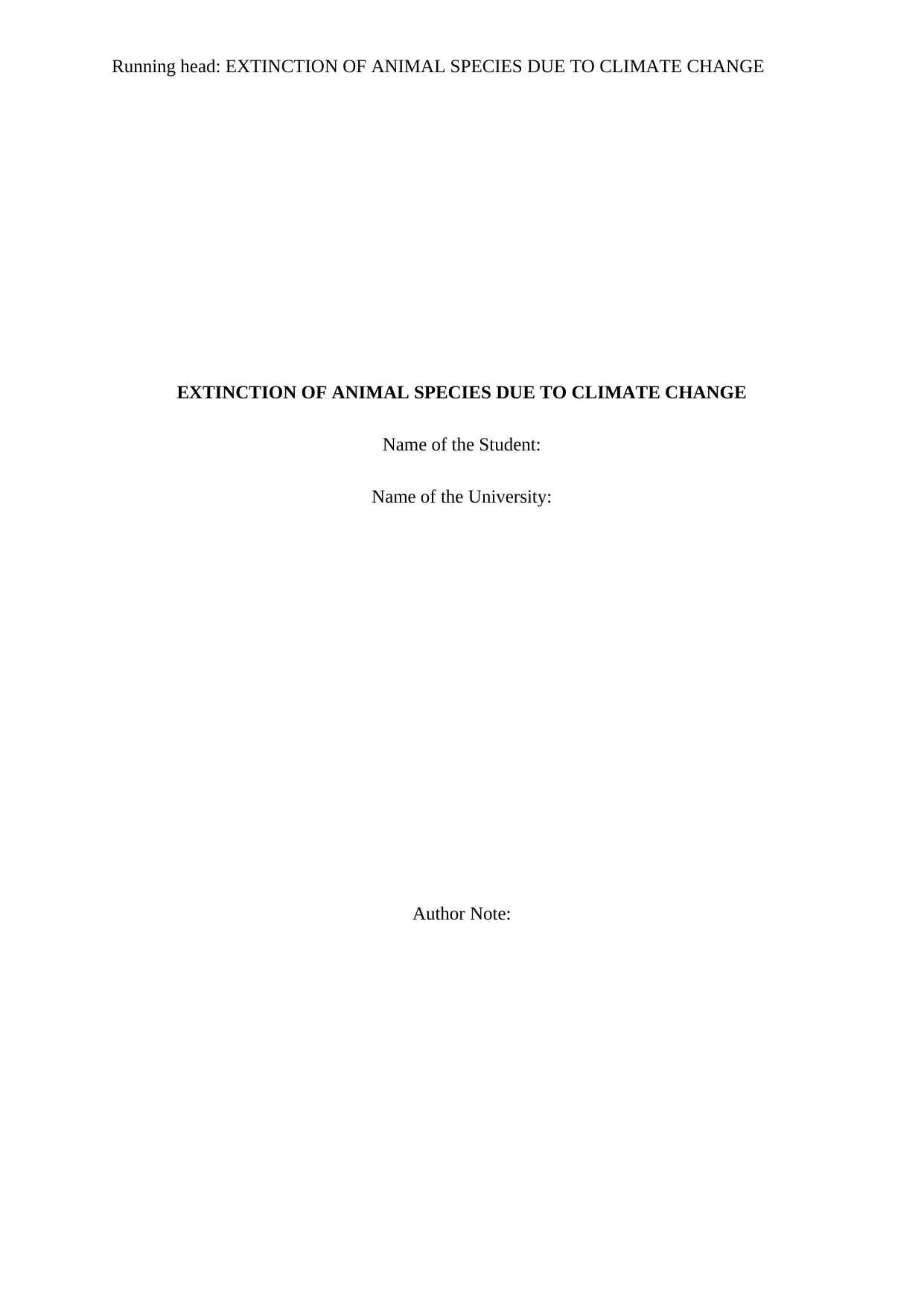
Running head: EXTINCTION OF ANIMAL SPECIES DUE TO CLIMATE CHANGE
EXTINCTION OF ANIMAL SPECIES DUE TO CLIMATE CHANGE
Name of the Student:
Name of the University:
Author Note:
EXTINCTION OF ANIMAL SPECIES DUE TO CLIMATE CHANGE
Name of the Student:
Name of the University:
Author Note:
Paraphrase This Document
Need a fresh take? Get an instant paraphrase of this document with our AI Paraphraser
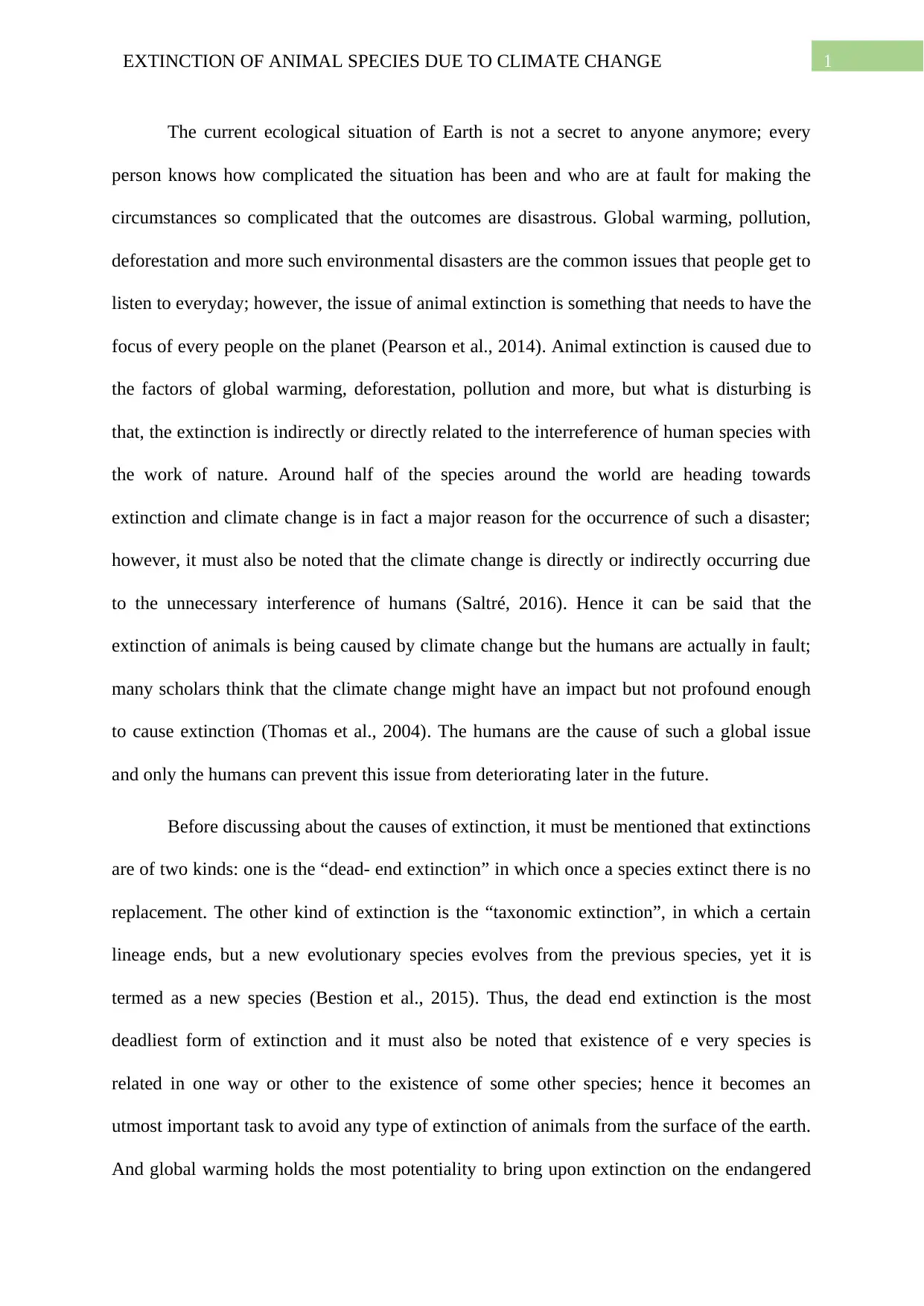
1EXTINCTION OF ANIMAL SPECIES DUE TO CLIMATE CHANGE
The current ecological situation of Earth is not a secret to anyone anymore; every
person knows how complicated the situation has been and who are at fault for making the
circumstances so complicated that the outcomes are disastrous. Global warming, pollution,
deforestation and more such environmental disasters are the common issues that people get to
listen to everyday; however, the issue of animal extinction is something that needs to have the
focus of every people on the planet (Pearson et al., 2014). Animal extinction is caused due to
the factors of global warming, deforestation, pollution and more, but what is disturbing is
that, the extinction is indirectly or directly related to the interreference of human species with
the work of nature. Around half of the species around the world are heading towards
extinction and climate change is in fact a major reason for the occurrence of such a disaster;
however, it must also be noted that the climate change is directly or indirectly occurring due
to the unnecessary interference of humans (Saltré, 2016). Hence it can be said that the
extinction of animals is being caused by climate change but the humans are actually in fault;
many scholars think that the climate change might have an impact but not profound enough
to cause extinction (Thomas et al., 2004). The humans are the cause of such a global issue
and only the humans can prevent this issue from deteriorating later in the future.
Before discussing about the causes of extinction, it must be mentioned that extinctions
are of two kinds: one is the “dead- end extinction” in which once a species extinct there is no
replacement. The other kind of extinction is the “taxonomic extinction”, in which a certain
lineage ends, but a new evolutionary species evolves from the previous species, yet it is
termed as a new species (Bestion et al., 2015). Thus, the dead end extinction is the most
deadliest form of extinction and it must also be noted that existence of e very species is
related in one way or other to the existence of some other species; hence it becomes an
utmost important task to avoid any type of extinction of animals from the surface of the earth.
And global warming holds the most potentiality to bring upon extinction on the endangered
The current ecological situation of Earth is not a secret to anyone anymore; every
person knows how complicated the situation has been and who are at fault for making the
circumstances so complicated that the outcomes are disastrous. Global warming, pollution,
deforestation and more such environmental disasters are the common issues that people get to
listen to everyday; however, the issue of animal extinction is something that needs to have the
focus of every people on the planet (Pearson et al., 2014). Animal extinction is caused due to
the factors of global warming, deforestation, pollution and more, but what is disturbing is
that, the extinction is indirectly or directly related to the interreference of human species with
the work of nature. Around half of the species around the world are heading towards
extinction and climate change is in fact a major reason for the occurrence of such a disaster;
however, it must also be noted that the climate change is directly or indirectly occurring due
to the unnecessary interference of humans (Saltré, 2016). Hence it can be said that the
extinction of animals is being caused by climate change but the humans are actually in fault;
many scholars think that the climate change might have an impact but not profound enough
to cause extinction (Thomas et al., 2004). The humans are the cause of such a global issue
and only the humans can prevent this issue from deteriorating later in the future.
Before discussing about the causes of extinction, it must be mentioned that extinctions
are of two kinds: one is the “dead- end extinction” in which once a species extinct there is no
replacement. The other kind of extinction is the “taxonomic extinction”, in which a certain
lineage ends, but a new evolutionary species evolves from the previous species, yet it is
termed as a new species (Bestion et al., 2015). Thus, the dead end extinction is the most
deadliest form of extinction and it must also be noted that existence of e very species is
related in one way or other to the existence of some other species; hence it becomes an
utmost important task to avoid any type of extinction of animals from the surface of the earth.
And global warming holds the most potentiality to bring upon extinction on the endangered
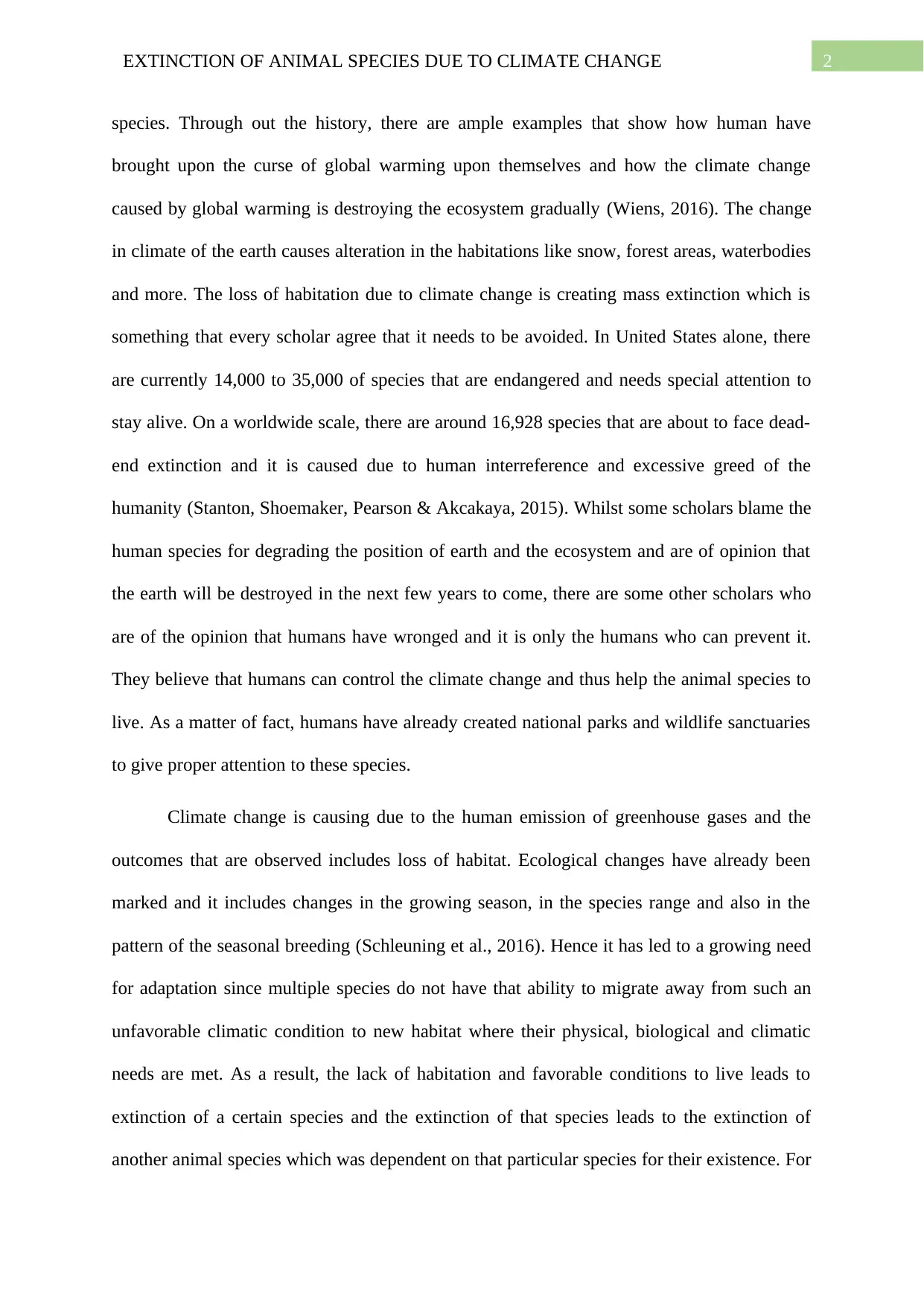
2EXTINCTION OF ANIMAL SPECIES DUE TO CLIMATE CHANGE
species. Through out the history, there are ample examples that show how human have
brought upon the curse of global warming upon themselves and how the climate change
caused by global warming is destroying the ecosystem gradually (Wiens, 2016). The change
in climate of the earth causes alteration in the habitations like snow, forest areas, waterbodies
and more. The loss of habitation due to climate change is creating mass extinction which is
something that every scholar agree that it needs to be avoided. In United States alone, there
are currently 14,000 to 35,000 of species that are endangered and needs special attention to
stay alive. On a worldwide scale, there are around 16,928 species that are about to face dead-
end extinction and it is caused due to human interreference and excessive greed of the
humanity (Stanton, Shoemaker, Pearson & Akcakaya, 2015). Whilst some scholars blame the
human species for degrading the position of earth and the ecosystem and are of opinion that
the earth will be destroyed in the next few years to come, there are some other scholars who
are of the opinion that humans have wronged and it is only the humans who can prevent it.
They believe that humans can control the climate change and thus help the animal species to
live. As a matter of fact, humans have already created national parks and wildlife sanctuaries
to give proper attention to these species.
Climate change is causing due to the human emission of greenhouse gases and the
outcomes that are observed includes loss of habitat. Ecological changes have already been
marked and it includes changes in the growing season, in the species range and also in the
pattern of the seasonal breeding (Schleuning et al., 2016). Hence it has led to a growing need
for adaptation since multiple species do not have that ability to migrate away from such an
unfavorable climatic condition to new habitat where their physical, biological and climatic
needs are met. As a result, the lack of habitation and favorable conditions to live leads to
extinction of a certain species and the extinction of that species leads to the extinction of
another animal species which was dependent on that particular species for their existence. For
species. Through out the history, there are ample examples that show how human have
brought upon the curse of global warming upon themselves and how the climate change
caused by global warming is destroying the ecosystem gradually (Wiens, 2016). The change
in climate of the earth causes alteration in the habitations like snow, forest areas, waterbodies
and more. The loss of habitation due to climate change is creating mass extinction which is
something that every scholar agree that it needs to be avoided. In United States alone, there
are currently 14,000 to 35,000 of species that are endangered and needs special attention to
stay alive. On a worldwide scale, there are around 16,928 species that are about to face dead-
end extinction and it is caused due to human interreference and excessive greed of the
humanity (Stanton, Shoemaker, Pearson & Akcakaya, 2015). Whilst some scholars blame the
human species for degrading the position of earth and the ecosystem and are of opinion that
the earth will be destroyed in the next few years to come, there are some other scholars who
are of the opinion that humans have wronged and it is only the humans who can prevent it.
They believe that humans can control the climate change and thus help the animal species to
live. As a matter of fact, humans have already created national parks and wildlife sanctuaries
to give proper attention to these species.
Climate change is causing due to the human emission of greenhouse gases and the
outcomes that are observed includes loss of habitat. Ecological changes have already been
marked and it includes changes in the growing season, in the species range and also in the
pattern of the seasonal breeding (Schleuning et al., 2016). Hence it has led to a growing need
for adaptation since multiple species do not have that ability to migrate away from such an
unfavorable climatic condition to new habitat where their physical, biological and climatic
needs are met. As a result, the lack of habitation and favorable conditions to live leads to
extinction of a certain species and the extinction of that species leads to the extinction of
another animal species which was dependent on that particular species for their existence. For
⊘ This is a preview!⊘
Do you want full access?
Subscribe today to unlock all pages.

Trusted by 1+ million students worldwide
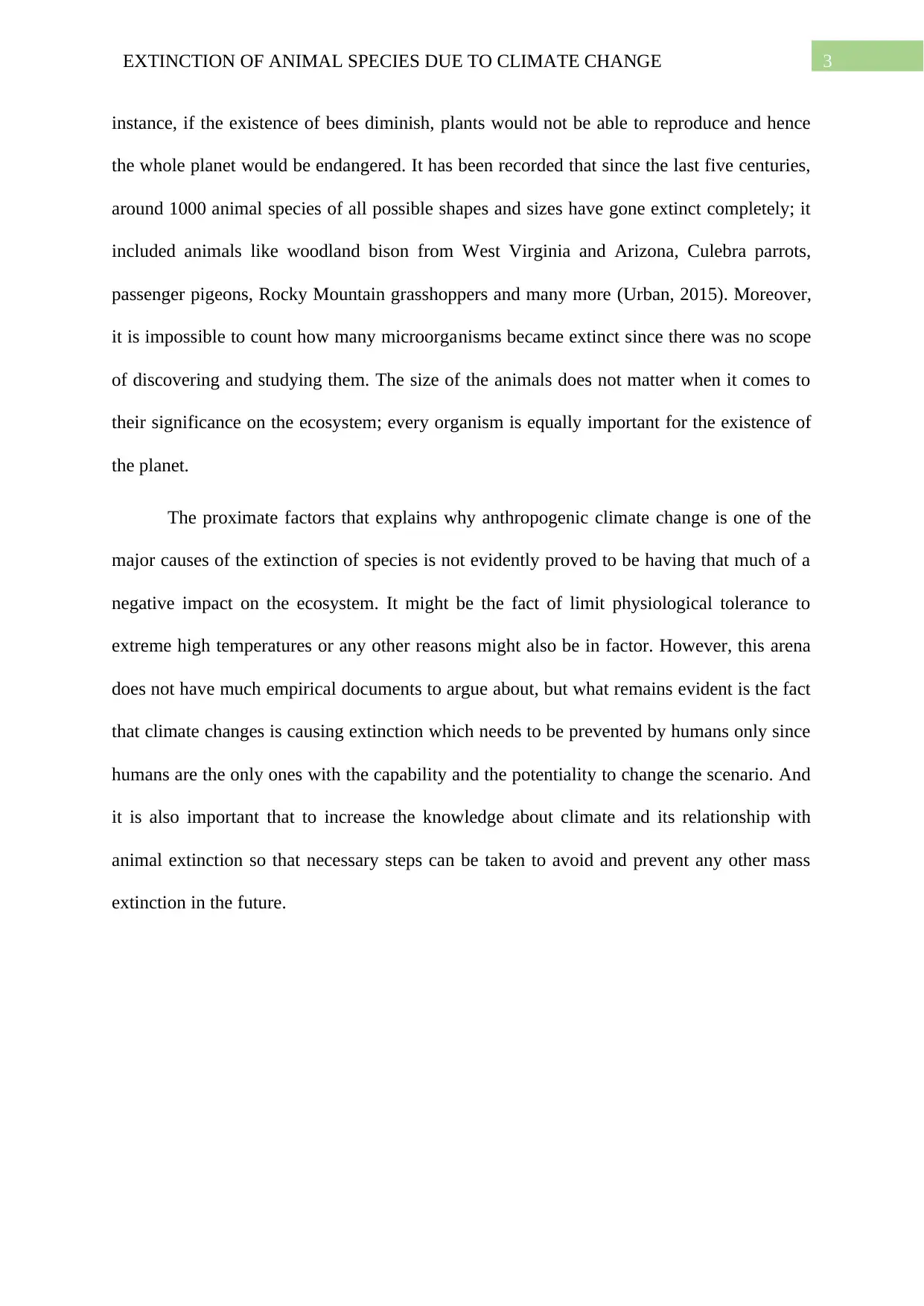
3EXTINCTION OF ANIMAL SPECIES DUE TO CLIMATE CHANGE
instance, if the existence of bees diminish, plants would not be able to reproduce and hence
the whole planet would be endangered. It has been recorded that since the last five centuries,
around 1000 animal species of all possible shapes and sizes have gone extinct completely; it
included animals like woodland bison from West Virginia and Arizona, Culebra parrots,
passenger pigeons, Rocky Mountain grasshoppers and many more (Urban, 2015). Moreover,
it is impossible to count how many microorganisms became extinct since there was no scope
of discovering and studying them. The size of the animals does not matter when it comes to
their significance on the ecosystem; every organism is equally important for the existence of
the planet.
The proximate factors that explains why anthropogenic climate change is one of the
major causes of the extinction of species is not evidently proved to be having that much of a
negative impact on the ecosystem. It might be the fact of limit physiological tolerance to
extreme high temperatures or any other reasons might also be in factor. However, this arena
does not have much empirical documents to argue about, but what remains evident is the fact
that climate changes is causing extinction which needs to be prevented by humans only since
humans are the only ones with the capability and the potentiality to change the scenario. And
it is also important that to increase the knowledge about climate and its relationship with
animal extinction so that necessary steps can be taken to avoid and prevent any other mass
extinction in the future.
instance, if the existence of bees diminish, plants would not be able to reproduce and hence
the whole planet would be endangered. It has been recorded that since the last five centuries,
around 1000 animal species of all possible shapes and sizes have gone extinct completely; it
included animals like woodland bison from West Virginia and Arizona, Culebra parrots,
passenger pigeons, Rocky Mountain grasshoppers and many more (Urban, 2015). Moreover,
it is impossible to count how many microorganisms became extinct since there was no scope
of discovering and studying them. The size of the animals does not matter when it comes to
their significance on the ecosystem; every organism is equally important for the existence of
the planet.
The proximate factors that explains why anthropogenic climate change is one of the
major causes of the extinction of species is not evidently proved to be having that much of a
negative impact on the ecosystem. It might be the fact of limit physiological tolerance to
extreme high temperatures or any other reasons might also be in factor. However, this arena
does not have much empirical documents to argue about, but what remains evident is the fact
that climate changes is causing extinction which needs to be prevented by humans only since
humans are the only ones with the capability and the potentiality to change the scenario. And
it is also important that to increase the knowledge about climate and its relationship with
animal extinction so that necessary steps can be taken to avoid and prevent any other mass
extinction in the future.
Paraphrase This Document
Need a fresh take? Get an instant paraphrase of this document with our AI Paraphraser
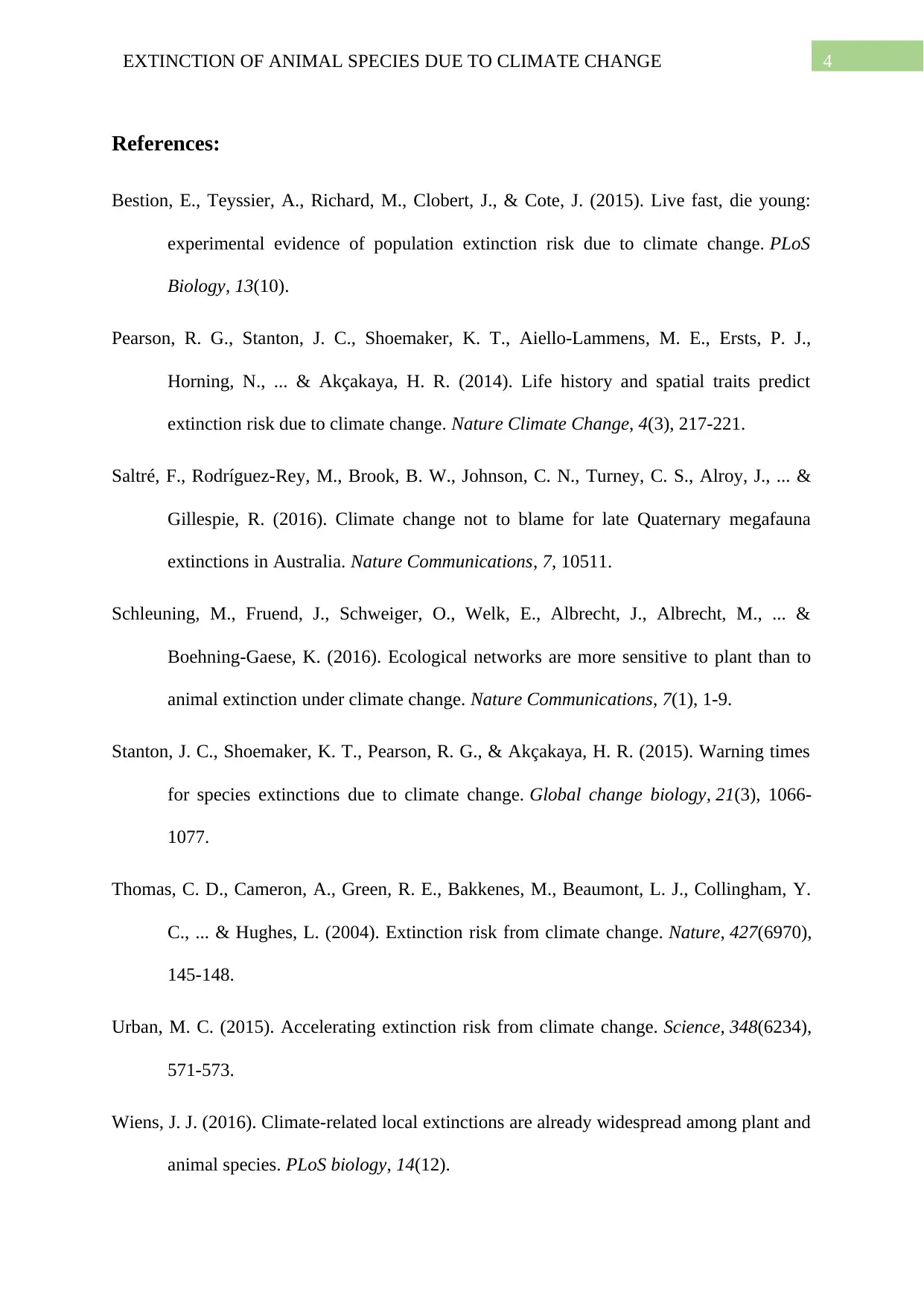
4EXTINCTION OF ANIMAL SPECIES DUE TO CLIMATE CHANGE
References:
Bestion, E., Teyssier, A., Richard, M., Clobert, J., & Cote, J. (2015). Live fast, die young:
experimental evidence of population extinction risk due to climate change. PLoS
Biology, 13(10).
Pearson, R. G., Stanton, J. C., Shoemaker, K. T., Aiello-Lammens, M. E., Ersts, P. J.,
Horning, N., ... & Akçakaya, H. R. (2014). Life history and spatial traits predict
extinction risk due to climate change. Nature Climate Change, 4(3), 217-221.
Saltré, F., Rodríguez-Rey, M., Brook, B. W., Johnson, C. N., Turney, C. S., Alroy, J., ... &
Gillespie, R. (2016). Climate change not to blame for late Quaternary megafauna
extinctions in Australia. Nature Communications, 7, 10511.
Schleuning, M., Fruend, J., Schweiger, O., Welk, E., Albrecht, J., Albrecht, M., ... &
Boehning-Gaese, K. (2016). Ecological networks are more sensitive to plant than to
animal extinction under climate change. Nature Communications, 7(1), 1-9.
Stanton, J. C., Shoemaker, K. T., Pearson, R. G., & Akçakaya, H. R. (2015). Warning times
for species extinctions due to climate change. Global change biology, 21(3), 1066-
1077.
Thomas, C. D., Cameron, A., Green, R. E., Bakkenes, M., Beaumont, L. J., Collingham, Y.
C., ... & Hughes, L. (2004). Extinction risk from climate change. Nature, 427(6970),
145-148.
Urban, M. C. (2015). Accelerating extinction risk from climate change. Science, 348(6234),
571-573.
Wiens, J. J. (2016). Climate-related local extinctions are already widespread among plant and
animal species. PLoS biology, 14(12).
References:
Bestion, E., Teyssier, A., Richard, M., Clobert, J., & Cote, J. (2015). Live fast, die young:
experimental evidence of population extinction risk due to climate change. PLoS
Biology, 13(10).
Pearson, R. G., Stanton, J. C., Shoemaker, K. T., Aiello-Lammens, M. E., Ersts, P. J.,
Horning, N., ... & Akçakaya, H. R. (2014). Life history and spatial traits predict
extinction risk due to climate change. Nature Climate Change, 4(3), 217-221.
Saltré, F., Rodríguez-Rey, M., Brook, B. W., Johnson, C. N., Turney, C. S., Alroy, J., ... &
Gillespie, R. (2016). Climate change not to blame for late Quaternary megafauna
extinctions in Australia. Nature Communications, 7, 10511.
Schleuning, M., Fruend, J., Schweiger, O., Welk, E., Albrecht, J., Albrecht, M., ... &
Boehning-Gaese, K. (2016). Ecological networks are more sensitive to plant than to
animal extinction under climate change. Nature Communications, 7(1), 1-9.
Stanton, J. C., Shoemaker, K. T., Pearson, R. G., & Akçakaya, H. R. (2015). Warning times
for species extinctions due to climate change. Global change biology, 21(3), 1066-
1077.
Thomas, C. D., Cameron, A., Green, R. E., Bakkenes, M., Beaumont, L. J., Collingham, Y.
C., ... & Hughes, L. (2004). Extinction risk from climate change. Nature, 427(6970),
145-148.
Urban, M. C. (2015). Accelerating extinction risk from climate change. Science, 348(6234),
571-573.
Wiens, J. J. (2016). Climate-related local extinctions are already widespread among plant and
animal species. PLoS biology, 14(12).
1 out of 5
Related Documents
Your All-in-One AI-Powered Toolkit for Academic Success.
+13062052269
info@desklib.com
Available 24*7 on WhatsApp / Email
![[object Object]](/_next/static/media/star-bottom.7253800d.svg)
Unlock your academic potential
Copyright © 2020–2025 A2Z Services. All Rights Reserved. Developed and managed by ZUCOL.




